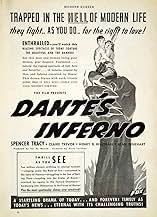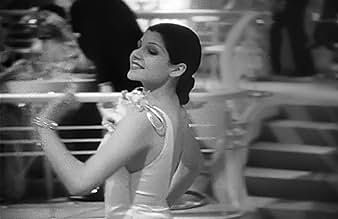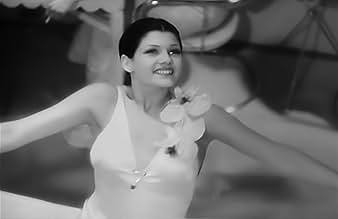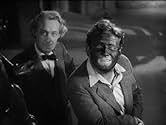Ajouter une intrigue dans votre langueJim Carter moves in on the McWade's carnival concession which shows scenes from Dante's "Inferno". He makes it a going concern, marrying Betty along the way. An inspector calls the amusement... Tout lireJim Carter moves in on the McWade's carnival concession which shows scenes from Dante's "Inferno". He makes it a going concern, marrying Betty along the way. An inspector calls the amusement pier unsafe but Carter bribes him. The pier collapses, leading to the inspector's suicide... Tout lireJim Carter moves in on the McWade's carnival concession which shows scenes from Dante's "Inferno". He makes it a going concern, marrying Betty along the way. An inspector calls the amusement pier unsafe but Carter bribes him. The pier collapses, leading to the inspector's suicide, injury to Pop McWade, trial for Carter, and Betty's leaving him. Carter starts over with... Tout lire
- Réalisation
- Scénario
- Casting principal
- Récompenses
- 1 nomination au total
- Alexander Carter
- (as Scott Beckett)
- Dancer
- (as Rita Cansino)
- Girl in Stoke-Hold
- (non crédité)
- Man in Stoke-Hold
- (non crédité)
- Mr. Williams
- (non crédité)
- Girl in Stoke-Hold
- (non crédité)
- Concessionaire's Wife
- (non crédité)
- Photographer
- (non crédité)
- Passenger in Boiler Room
- (non crédité)
- Amusement Park Patron
- (non crédité)
Avis à la une
Tracy plays a man who lucks into carnival barking as a result of meeting a man, played by Henry B. Walthall, who runs a concession known as "Dante's Inferno." Walthall soon becomes Tracy's father-in-law, and Tracy becomes a successful businessman.
He launches a huge, gaudy Inferno employing ruthless means to get the property. Though a wonderful husband and father, in his corporate world, he stops at nothing to get what he wants, including cheating, bribery, and ignoring possible dangers. The consequences are disastrous.
The film has an obvious allegory, and I'm still laughing at a previous poster who noted that when Walthall goes through a book with Tracy and the seven rungs of hell come to life, everyone had great physiques so hell must not take chubsters! It's true!
Other than hell's preference for perfect 10s, the effects are amazing - the Inferno concession, the images in the book that come to life, and the fantastic ship scene which uses the Inferno images to great effect.
Spencer Tracy is excellent in his role, a tender dad, sweet husband and cruel businessman all at the same time. Claire Trevor is young and lovely and provides strong support for Tracy.
A very interesting film and highly recommended.
Tracy plays a ship stoker and would be con man who gets fired off his ship for malingering. Down on his luck, kindly old Henry B. Walthall who owns a sideshow attraction at a carnival midway takes him in and Walthall's daughter Claire Trevor falls for him.
Spence is nothing if not determined to make something of himself and he becomes a rich man in the amusement game. But his ethics leave a lot to be desired.
The title is not Dante Alighieri's famous poetic saga of his journey through hell, but it's the name of the exhibit that Walthall owns. It's 'educational' but Tracy starts on his road to financial success by glamorizing the more prurient aspects of it.
The Inferno catches fire and there's a climatic ship's fire as well that Cecil B. DeMille could not have staged better. One wishes the film had been in color for that as well as the imaginary ten minute journey through hell that Walthall describes to Tracy.
The dancing team on the ship before the fire marks the screen debut of one Marguerite Carmen Cansino or better known as Rita Hayworth. She was quite the dancer on screen as well as in this person's opinion, the biggest sex symbol the screen ever knew.
Dante's Inferno was a fine film for Tracy to leave Fox with. But it would have astonished the executives at Fox if they could have imagined the career direction it would take at MGM.
This film was inspired by (but is not a remake of) a 1924 film with the same title: both films have the same premise but very different plotlines.
We first see Tracy's character Jim Carter on the bottom rung: the Depression is on, and Carter is so desperate he takes a job as a blackface performer. Then he gets a job in a carnival attraction which offers the customers a quick ride through Hell (made of papier-mache).
There's a brilliant performance by Alan Dinehart, one of those great supporting actors from Hollywood's golden age. Dinehart specialised in playing sharp guys on the edge of the law (or slightly beyond it), and this is one of Dinehart's best roles. Henry Walthall, the silent-film star, is also excellent here.
The standout sequence in the film begins when Tracy is in hospital, recovering from injuries. Walthall brings him a copy of Dante's "Inferno", and proceeds to describe the horrible fates awaiting sinners in the afterworld. On screen, we see a series of stark tableaux in which naked men and women suffer eternal torments in Hell ... dodging flames, writhing in chains, turning into trees. For some reason, all the naked people in Hell have gorgeous physiques: apparently Hell doesn't take any chubsters.
"Dante's Inferno" is often mentioned by Rita Hayworth fans, because this movie includes one of her very earliest film roles. (She was still performing as Margarita Cansino, her original name.) Hayworth/Cansino appears very briefly as a ballroom dancer aboard Tracy's gambling ship. This is a standout film, but if you think it's a Rita Hayworth movie you'll be disappointed.
I strongly recommend "Dante's Inferno".
The movie's basically a morality tale, showing one man's (Tracy) ruthless climb from bottom to top and learning his lesson after all. I really like the way Carter ingratiates himself socially into the upper class; just having big bucks is not enough. So he uses is well-honed entrepreneurial skills to grease the wheels. And, thanks reviewer Albertsanders for detailing how the story's basis lies in actual fact, surprising as that may seem.
My only complaint is the miracle ending. It sure doesn't comport with the events aboard ship. My guess is that it was a gesture to the newly formed Production Code. Or maybe it was just pandering to what the studio thinks audiences want. Either way, it undercuts a good story and maybe the best special effects of the time.
This is a stand alone film that is unique, off beat, wild and profound. A visual display of a catastrophe of material and man. It is a stunning piece of work that was rarely shown on television and ignored as a bastard child of the bijou. The middle inclusion of a horrific Hell with suffering half-naked souls and with haunting, chilling musical accompaniment is partly responsible.
There are three set pieces in this remarkable movie that are unforgettable and the story of greed and decadence is timeless. This is a one of a kind, disturbing adventure put together with excellent special effects, costumes, and sets. An underrated, overlooked antique piece of propagandized art that remains relevant. "things don't change, the behavior of men remains the same throughout history", says the old man. Amen.
Le saviez-vous
- AnecdotesSpencer Tracy's erratic behavior on this film helped seal his fate with 20th Century-Fox. During filming Tracy disappeared from the set for weeks while on a drunken binge. He reportedly also showed up to the set one day surly and hung over and fell asleep in the "Manhattan apartment" set. The studio locked the stage while he was still asleep; Tracy woke up in a rage and started destroying sets, reportedly causing thousands of dollars worth of damage for which the studio billed him.
- GaffesToutes les informations contiennent des spoilers
- ConnexionsEdited into Myra Breckinridge (1970)
- Bandes originalesThe Wedding March
(1843) (uncredited)
from "A Midsummer Night's Dream, Op.61"
Written by Felix Mendelssohn
Played on a hurdy-gurdy for the wedding photograph
Meilleurs choix
- How long is Dante's Inferno?Alimenté par Alexa
Détails
- Date de sortie
- Pays d’origine
- Langue
- Aussi connu sous le nom de
- Dante's Inferno
- Lieux de tournage
- Ocean Park Pier, Santa Monica, Californie, États-Unis(exterior views showing rides including Loop-O-Plane and Chute-the-Chutes)
- Société de production
- Voir plus de crédits d'entreprise sur IMDbPro
Box-office
- Budget
- 748 900 $US (estimé)
- Durée1 heure 29 minutes
- Rapport de forme
- 1.37 : 1
Contribuer à cette page







































